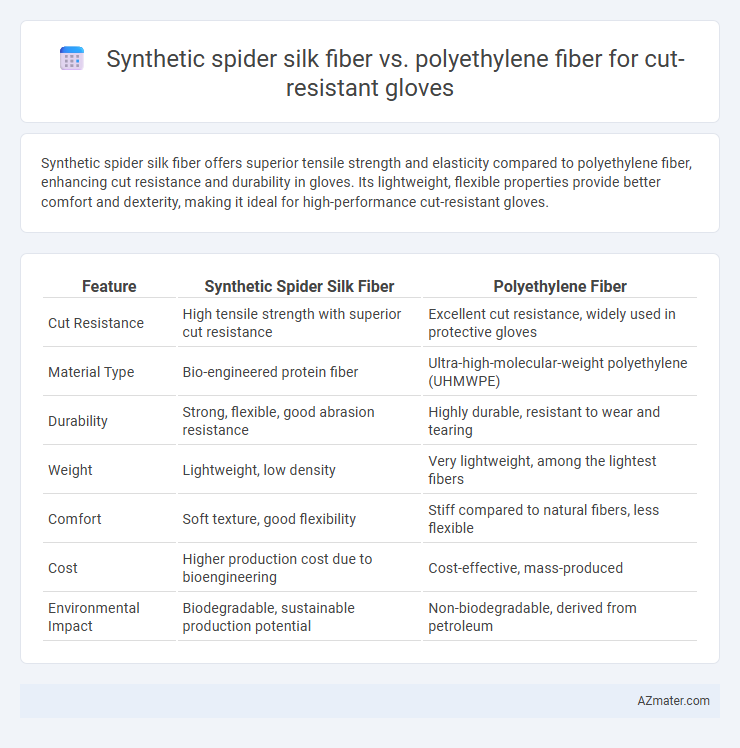Synthetic spider silk fiber offers superior tensile strength and elasticity compared to polyethylene fiber, enhancing cut resistance and durability in gloves. Its lightweight, flexible properties provide better comfort and dexterity, making it ideal for high-performance cut-resistant gloves.
Table of Comparison
| Feature | Synthetic Spider Silk Fiber | Polyethylene Fiber |
|---|---|---|
| Cut Resistance | High tensile strength with superior cut resistance | Excellent cut resistance, widely used in protective gloves |
| Material Type | Bio-engineered protein fiber | Ultra-high-molecular-weight polyethylene (UHMWPE) |
| Durability | Strong, flexible, good abrasion resistance | Highly durable, resistant to wear and tearing |
| Weight | Lightweight, low density | Very lightweight, among the lightest fibers |
| Comfort | Soft texture, good flexibility | Stiff compared to natural fibers, less flexible |
| Cost | Higher production cost due to bioengineering | Cost-effective, mass-produced |
| Environmental Impact | Biodegradable, sustainable production potential | Non-biodegradable, derived from petroleum |
Introduction to Cut-resistant Glove Materials
Synthetic spider silk fiber offers exceptional tensile strength and flexibility, outperforming traditional materials in cut-resistant gloves due to its natural protein structure mimicking real spider silk. Polyethylene fiber, specifically ultra-high-molecular-weight polyethylene (UHMWPE), is widely utilized for cut-resistant gloves, providing high abrasion resistance and lightweight durability. Both materials enhance glove performance by improving cut resistance, with synthetic spider silk showing promising advancements in elasticity and strength compared to polyethylene fibers.
Overview of Synthetic Spider Silk Fiber
Synthetic spider silk fiber exhibits exceptional tensile strength and flexibility, surpassing many traditional materials such as polyethylene fiber in cut-resistant glove applications. Its biocompatibility and lightweight nature enhance user comfort while providing superior abrasion resistance and durability. Ongoing advancements in recombinant protein technology continue to improve synthetic spider silk's scalability and cost-effectiveness compared to conventional polyethylene fibers.
Properties of Polyethylene Fiber
Polyethylene fiber, specifically ultra-high-molecular-weight polyethylene (UHMWPE), offers exceptional cut resistance due to its high tensile strength and low density, making gloves lightweight and durable. This fiber exhibits excellent chemical resistance, low moisture absorption, and high abrasion resistance, enhancing the glove's longevity in harsh environments. Compared to synthetic spider silk fiber, polyethylene fiber provides superior stiffness and impact resistance, critical for industrial cut-resistant glove applications.
Mechanical Strength Comparison
Synthetic spider silk fiber exhibits exceptional tensile strength and toughness, often surpassing traditional polyethylene fibers used in cut-resistant gloves. Spider silk fibers can achieve tensile strengths up to 1.75 GPa with remarkable elasticity, enhancing glove durability and resistance against sharp objects. In contrast, polyethylene fibers like UHMWPE provide high strength around 2.4 GPa but lack the flexibility and resilience of synthetic spider silk, affecting overall mechanical performance in cut resistance applications.
Flexibility and Comfort Analysis
Synthetic spider silk fiber exhibits superior flexibility compared to polyethylene fiber, allowing for enhanced dexterity and movement in cut-resistant gloves. The natural elasticity and lightweight structure of synthetic spider silk contribute to increased comfort during prolonged wear by reducing hand fatigue. Polyethylene fibers, while strong, tend to be stiffer and less breathable, potentially compromising glove comfort and flexibility.
Cut Resistance Performance
Synthetic spider silk fiber exhibits superior cut resistance performance compared to polyethylene fiber due to its exceptional tensile strength and molecular structure that dissipates energy efficiently upon impact. Research indicates that gloves reinforced with synthetic spider silk fibers achieve higher ANSI/ISEA cut scores, providing enhanced protection in high-risk environments. Polyethylene fibers, while lightweight and strong, typically demonstrate lower resistance to sharp object penetration, making synthetic spider silk a preferred choice for advanced cut-resistant gloves.
Environmental Impact and Sustainability
Synthetic spider silk fiber, engineered from bioengineered proteins, offers superior biodegradability compared to conventional polyethylene fiber, which is derived from petroleum and poses long-term environmental persistence. The production of synthetic spider silk typically involves lower greenhouse gas emissions and reduced reliance on non-renewable resources, enhancing its sustainability profile. In contrast, polyethylene fiber manufacturing generates significant plastic waste and microplastics, raising concerns over ecological harm and recyclability in cut-resistant glove applications.
Cost and Production Scalability
Synthetic spider silk fiber offers superior mechanical properties and high cut resistance but faces significant challenges in cost and production scalability due to complex bioengineered manufacturing processes. Polyethylene fibers, particularly ultra-high-molecular-weight polyethylene (UHMWPE), provide a cost-effective alternative with established large-scale production capabilities, making them more accessible for mass-produced cut-resistant gloves. The relatively lower price and scalable manufacturing infrastructure of polyethylene fibers currently outweigh synthetic spider silk despite its advanced performance potential.
Potential Applications in PPE Market
Synthetic spider silk fiber offers exceptional tensile strength and flexibility, making it ideal for cut-resistant gloves in high-risk PPE applications such as industrial manufacturing, construction, and firefighting. Polyethylene fiber, known for its lightweight and high cut resistance, excels in lightweight protective gloves widely used in automotive assembly, food processing, and sharp object handling. Both materials enhance durability and protection, but synthetic spider silk's superior elasticity provides increased comfort and dexterity for prolonged wear.
Future Prospects and Innovations
Synthetic spider silk fiber exhibits superior tensile strength and elasticity compared to polyethylene fiber, positioning it as a promising material for next-generation cut-resistant gloves. Innovations in bioengineered silk production and nanotechnology integration are expected to enhance its durability and cost-effectiveness, potentially outperforming conventional polyethylene fibers in protective performance. Future developments in fiber blending and molecular design aim to create lightweight, highly flexible gloves with improved resistance to sharp objects and abrasions.

Infographic: Synthetic spider silk fiber vs Polyethylene fiber for Cut-resistant glove
 azmater.com
azmater.com